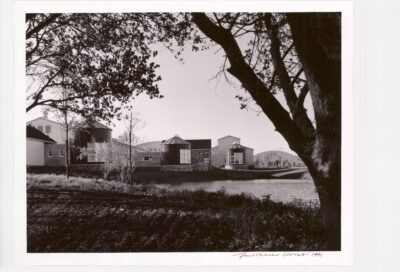Design Profession: Firm
Building Types: Commercial, Educational, Residential

The Herman Miller Furniture Company is one of the most influential furniture makers of the modern era. Their designs have inspired generations of architects, designers, and artists.
Herman Miller began its business life in 1905, as the Michigan Star Furniture Company, a manufacturer of reproduction period furniture pieces. In 1909 Dirk Jan (D. J.) De Pree was hired by the company as a clerk and office assistant and within ten years was named its president. In 1923 De Pree asked his father-in-law, Herman Miller, to loan him the funds to purchase a controlling interest in the company. Miller agreed. Upon De Pree's purchase of the company, he changed its name to the Herman Miller Furniture Company to honor his father-in-law's contribution.
Herman Miller continued to produce reproduction furniture until the onset of the Great Depression. Gilbert Rohde, a designer who had developed a line of modern furniture for Haywood-Wakefield, approached De Pree and suggested that the Herman Miller Company needed innovative, modern designs in order to flourish. De Pree took a chance on Rohde and in 1932 their partnership resulted in bedroom group No. 2185, the first line of modern furniture Rohde designed for the company. Rohde's modern furniture was exhibited in the Design for Living house at the Century of Progress in Chicago in 1933 and met with great success. The experience convinced D. J. De Pree that modern design was the right direction for Herman Miller's future, and in 1934, under Rohde's direction, Herman Miller published its first catalog of entirely modern furniture. Rohde helped to fuel interest in modern design through an innovative merchandising program he devised for Herman Miller that granted franchises to a limited number of upscale department stores and instituted strict guidelines for the furniture's display.
The partnership between Herman Miller and Gilbert Rohde was a tremendous success. Rhode's untimely death in 1944 forced De Pree to search for a designer who could carry on the tradition of design innovation and quality that Rohde had founded at Herman Miller. After seeing photographs in Life magazine of a storage wall unit designed by George Nelson, De Pree was confident that Nelson was the right successor but it took him almost a year to convince Nelson to take the job. In the postwar world, Nelson helped take the Herman Miller Company to new heights in modern design. Along with his own personal design accomplishments at Herman Miller, such as the Storage Wall Unit, the Ball Clock, and Marshmallow Sofa, Nelson is credited with bringing dynamic designers to the company like Charles and Ray Eames, Alexander Girard, Isamu Noguchi, and Robert Probst. As a result, Herman Miller has produced many iconic furniture pieces that define American Modernism. These include the Eames Lounge Chair and Eames' plywood and fiberglass chairs, Girard's folk art based fabrics, Noguchi's biomorphic glass and wood coffee table, and the Action Office by Probst.
The company remained under the direction of the De Pree family as D. J.'s sons Max and Hugh took over the company in the 1960s. The Herman Miller Company adopted a business philosophy based on responsibility, integrity, and employee participation. Today, Herman Miller continues to maintain a worldwide presence in the furniture industry with a solid reputation for design innovation. The company's products push the boundaries of traditional furniture solutions focusing on ergonomics, sustainability, and style.
